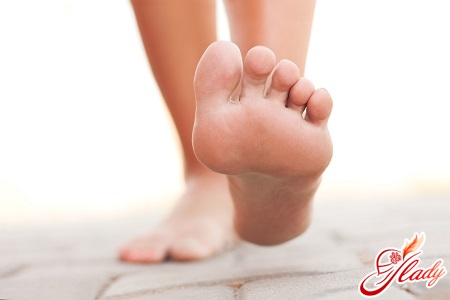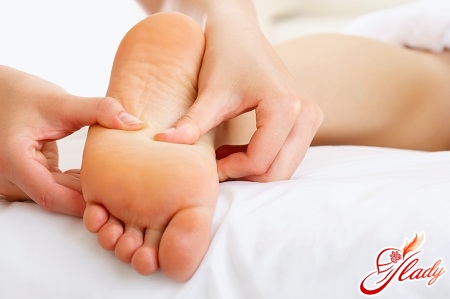
Hallux valgus- this is a familiar and rather unpleasant disease to many, when a growth begins to appear on the side of the foot, accompanied by pain. From a medical point of view, there is a deformation of the bones of the toe beyond the foot, that is, the metatarsal bone moves away from the other toes to the side. This requires long-term, complex treatment, since otherwise inflammation and pain when walking are possible.
The causes of deformities of the foot: where does the ailment come from?
The causes of big toe deformation are the mostvarious, most often it is pathological pressure on the area of the big toe, wearing improperly selected, tight shoes, high heels, which do not allow the load on the foot to be distributed correctly. Professional ballerinas and dancers are often susceptible to this disease, the gene factor is of great importance. The degree of curvature can only be fully determined by X-ray of the foot. An ultrasound examination is often recommended, which will show whether there is a circulatory disorder in the area, whether any additional treatment measures are needed.
Treatment: from physiotherapy to surgery
Treatment of hallux valgus always begins withselection of shoes that should not cause discomfort when worn, can stop the progression of the deformation. Often, pain is caused by the fact that the shoes are simply not suitable for such a disease, squeeze the foot, provoke inflammatory processes. There are special orthopedic products that help reduce pressure on the bursa of the finger, pads, spacers that help splint the finger, remove the load on the foot. But such treatment only helps to relieve inflammation and remove pain, the growth still remains, so surgery is often prescribed after this. Drug treatment is injections of corticosteroids, which help relieve inflammation. That is, with the help of specially selected drugs, you can reduce pain when walking, remove inflammation, but you will not be able to get rid of the growth itself in this way. Injections are often prescribed before surgery to remove bursitis. Hallux valgus can be treated in a variety of ways, but surgery is most often prescribed. The main tasks in such treatment are as follows:
- removal of bursitis of the thumb;
- reconstruction of the bone, its position relative to the remaining bones of the feet;
- balancing the muscles around the joint in such a way that the deformation does not repeat.
Most often, in very complex cases or stronglyprotruding lump (i.e. when curvature is maximal) it is recommended to remove the growth. Such removal is performed as follows: the skin on the leg in the area of the growth is cut, after which the growth itself is removed using a surgical chisel. The skin incision is sutured with small stitches. Such an operation is performed when bursitis has already formed. In some cases, additional bone reconstruction is required, returning the normal angle. After the operation, a rehabilitation period is necessary, during which bed rest is recommended, no loads on the sore leg.
Distal and proximal osteotomy
In some cases it is necessary to cutdistal end of the bone. This allows to reduce the angle between the metatarsal bones. The operation requires only a few small incisions, all bones after obtaining a satisfactory position are fixed with metal pins, removed three to six weeks after the operation. Loads after the operation are not recommended, it is necessary to observe the rehabilitation period, follow the recommendations of the attending physician. Such surgical intervention is performed as follows: the first metatarsal bone is cut at the proximal end, then the bone is reconstructed and fixed in the required position with metal pins. Such surgical intervention allows to reduce the angle between the metatarsal bones of the foot, during the operation, the tendons of the muscle that sets the big toe in motion are released. After the operation, a special bandage is put on the foot. Such an intervention is considered relatively gentle, the rehabilitation period does not take much time, but still the doctor's recommendations, bed rest must be followed exactly.
Rehabilitation period: how fast can you recover from surgery?
The operation is performed under general anesthesia, afterAfter the operation, a very tight, elastic bandage is applied to the leg, and the foot must be properly fixed. You are allowed to move your toes only on the second day after the operation, you can lower your legs out of bed on the third day, and you can walk (that is, put weight on the operated leg) only ten days after the operation. Full weight-bearing on the foot is allowed a month after the operation, strict bed rest is required. All recommendations and instructions must be followed exactly, since proper healing depends on this. The entire rehabilitation period takes at least six months, during which time physical activity, sports, and walking in heels are strictly contraindicated. To prevent the recurrence of this disease, you must wear special shoes with orthopedic insoles. On average, it takes about eight weeks for the leg to heal after the operation, during which time the foot must be fixed with a bandage, which prevents the leg from being injured. In very difficult cases, after surgery, you will have to move around with crutches for some time. In case of pronounced bursitis, physiotherapy is prescribed in the postoperative period, shoes should be worn only with a widened front, and correctors should be used. Compliance with such conditions will reduce the rehabilitation period and avoid recurrence of the disease.
Contraindications and possible complications
Surgical intervention can be performed notin all cases. Thus, the presence of local inflammatory processes is the main contraindication for surgery. Surgical interventions cannot be performed if there is thrombophlebitis, pronounced edema, for women - during menstruation. In each individual case, the treatment regimen for hallux valgus is prescribed strictly individually in accordance with the general health condition, the degree of the disease, the presence of contraindications to a particular method of combating the disease. After surgery, it is necessary to strictly adhere to the regimen prescribed by the attending physician, otherwise various complications may arise, which is fraught with inflammation, severe pain. As with any surgical intervention, complications are possible after foot surgery. Usually these are hematomas, inflammatory processes in the area of the big toe, but they can be avoided quite easily by simply following the doctor's recommendations. After surgery, it is necessary to adhere to the treatment regimen, do not load the leg. In the first days after surgery, painful sensations may be observed in the area of the metatarsophalangeal joint, depending on the individual characteristics of the patient's body, scars may form. An unsightly bump versus orthopedic shoes Many of us have encountered such an unpleasant phenomenon when the big toe first begins to hurt, and then a protruding bone appears on the side. This phenomenon is one of the most common, it is a manifestation of transverse flatfoot. Progressive disease provokes displacement of the head of the metatarsal bone, that is, the so-called deviation of the big toe to the side from the rest occurs. At this time, an unsightly bump forms on the side of the foot, which causes a lot of inconvenience: from painful sensations when walking to inflammation, unaesthetic appearance. The most common treatment prescribed for hallux valgus is the use of special shoes, but physiotherapy methods are often prescribed, and in especially difficult cases, surgery is performed.









